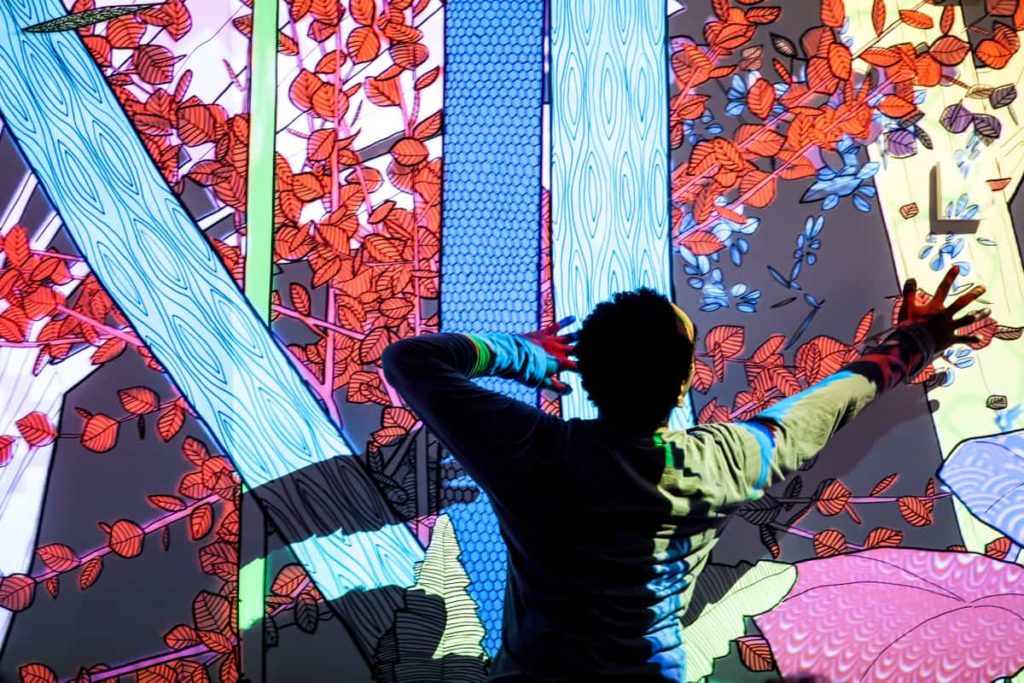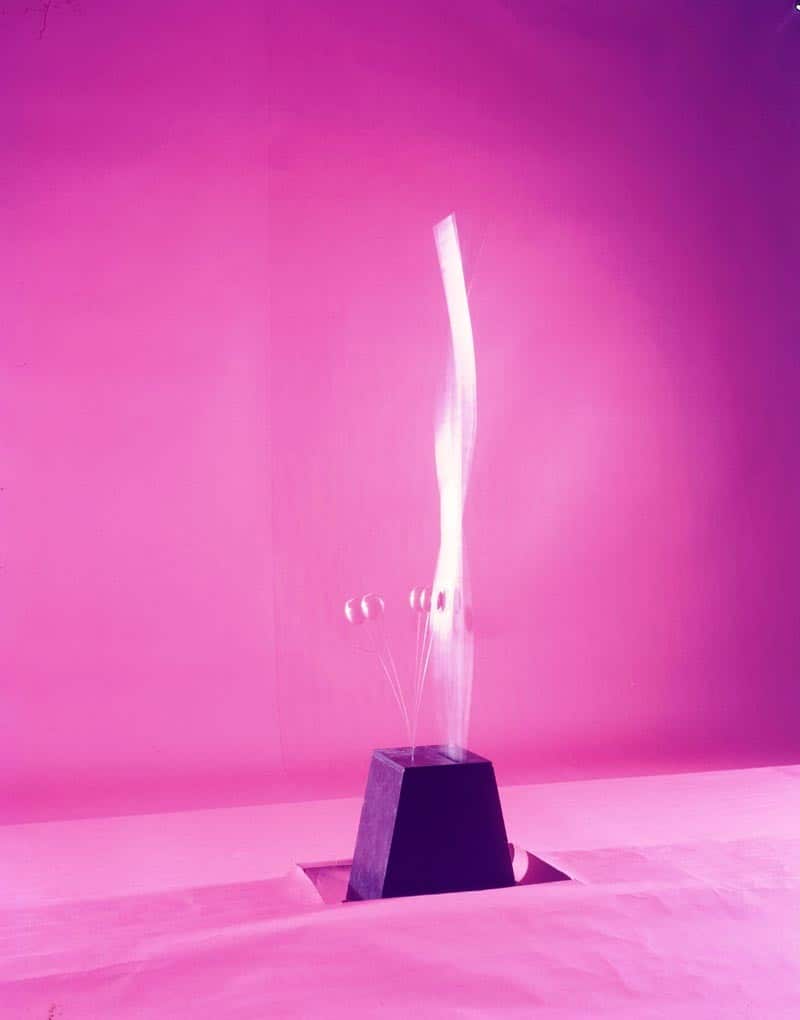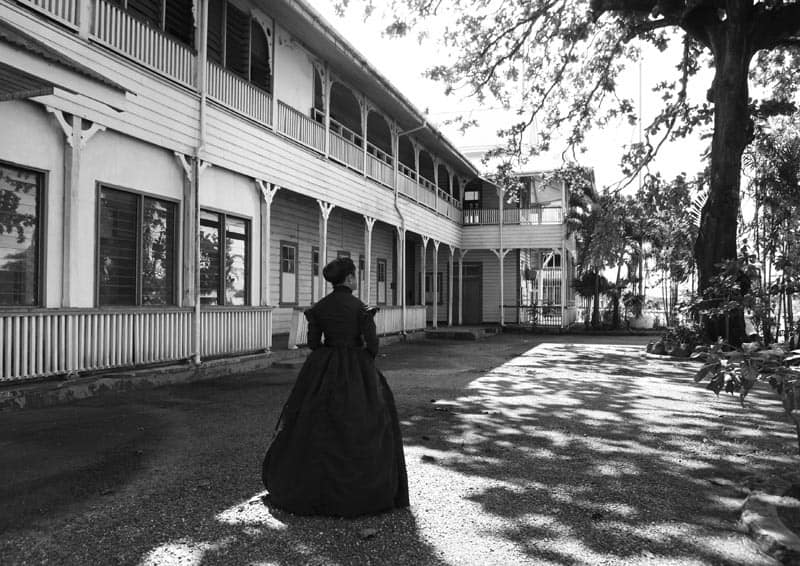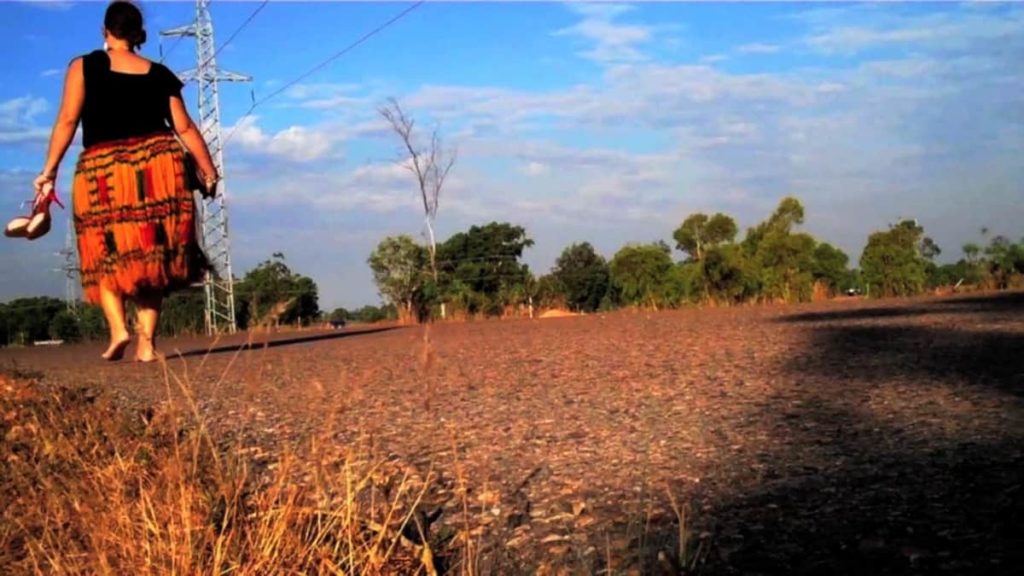
Rosanna Raymond
Aotearoa New Zealand b. 1967
the SaVAge K’lub Installation view. Photographer N. Harth
Courtesy Queensland Art Gallery l Gallery of Modern Art
The 8th Asia Pacific Triennial of Contemporary Art
Over 23 years, the ceaseless quest of the Asia Pacific Triennial, developed by the Queensland Art Gallery of Modern Art (QAGOMA), has been to test the boundaries of what represents contemporary art from the Asia Pacific region, to challenge Eurocentric conventions and attitudes, and to recognise the great diversity of artistic talent across this vast geographic zone. Through the APT audiences experience encounters with art beyond the western orthodoxies of contemporary art. It encompasses and counter-poses cosmopolitan, vernacular and indigenous art, while reflecting western and non-western worldviews and accepting that they are expressed with distinctive cultural practices. Artists are linked across national boundaries and aesthetic realms by shared humanistic concerns, whether human rights, environmental crises, issues of gender and recognition. As Chris Saines, the current Director of QAGOMA, reflected, the APT, “has become central to the discourse around art in the Asia Pacific region”. This article reviews the selection of Pacific art at the APT8, the artist/curator collaborative process behind its presentation, and the evolution of the current discourse.
Since its earliest formulations in the 1990s, successive APTs have included many genres of painting, sculpture, installation, video art and cinema. As well, individual and collective live art, performance, and the body have featured prominently as key elements, especially in the Pacific presence. Although the selection of artists and presentation of their artworks has continually morphed, performative elements are now embedded as distinctive aspects of this landmark event. In his overview of the APT’s evolution Saines commented that:
The earliest conversations we had around APT8 were driven by a strong instinct that performance and the body were key to contemporary art practice in the region . . . As we began to shape APT8, the rise in prominence of figuration and performance felt like a culmination of sorts.
Encountering Pacific art in its own settings and contexts, transcends western categorisations by definitions of art and craft, plastic arts and performance, genres blur, long established boundaries dissolve. Central to Pacific Islander’s artistic life is its connectivity to every aspect of their cultural life—their groundedness in place, the consensus of collective creativity, their interconnected relationships, the inter-animation of past and present, the fluidity between traditional and contemporary.
Pacific versions of ‘live’ art exploded onto APT stages in 1996, when Wendi Choulai presented Egu Rami for APT2, which involved reuniting through ceremony some forty members of the extended Solien Besena Clan of the Motu-Koitapu people, who live near Port Moresby, the capital of Papua New Guinea, with their relatives in the diaspora of the clan who live in Queensland, Australia.n 1999 at APT3Michel Tuffery’s and Patrice Kaiilekofe’s massive mechanised ‘bull fight’ performance presented a spectacle enlivened by troupes of dancers recruited from Brisbane’s Pasifika population.
The long process of negotiation with elders and custodians of art forms that are the province of initiated men, with regard to their intellectual property, content, presentation and performative aspects was exemplified in APT7 by Kwoma Arts and Brikiti from the Sepik region of Papua New Guinea.
For APT8, two large, total immersion gallery spaces were created within GOMA for artist-audience encounters. One housed the SaVAge K’lub installation along with random appearances of K’lubers, the other Nicolas Mole’s case (dwelling) and magical surrealist jungle, a human-scale digital environment where Yumi Danis was performed. Ruth McDougall conducted field research and drew on artist/collaborators to engage in creative dialogues and exploratory encounters over a long-term developmental period for these two major projects.
Rosanna Raymond and her Pasifika cohort targeted ‘ooga-booga’–pompous colonial attitudes towards ‘savages’ and stereotyped representations of Pacific cultural objects in museum and private collections (One of the founders of Pacific Sisters with their flagrant body art/costume/performances, Raymond led the remarkable collaboration, Pasifika Styles, between Pasifika artists and the Cambridge Museum of Archaeology and Anthropology in 2006, now a legendary event of contemporary artists’ intervention in historic museum spaces). In the SaVAge K’lub’s imaginary museum space, the contemporary relevance of Pacific fibre arts, textiles and self-adornment was animated by the K’lubers, interacting familiarly with the objects on display and curious audiences—with some ooga-booga thrown in for entertainment value.
Contrary to popular belief, the Savage Club was named after Richard Savage, a rather bohemian English poet and bon vivant, rather than a term favoured by colonialists who deemed that taming the savages and heathens was the white man’s burden. Founded in London in 1857, the Savage Club spawned branches in other colonial heartlands including Vancouver and Melbourne. A gentleman’s club (no women, savages or heathens of other races admitted), it prided itself in literature, art and adventure. The Club’s members in London, Vancouver and Melbourne—some of whom were serious scholars and connoisseurs—amassed remarkable nineteenth and twentieth-century collections of curios, ethnographic specimens and tribal art. But, as Raymond suggests, once the personal knowledge and interest of the original collectors had passed away with them, these ad hoc collections in the Savage Clubs became so much ‘ooga booga’, locked in stereotyped concepts of primitive art.
Creating her own SaVAge K’lub, peopling it with Islander artists/actors and filling the space with historic and newly created taonga (treasures, the Maori word for artworks that are replete with meanings and values), the SaVAge K’lub at APT8 is open to people of all genders, nationalities and interests. As Raymond explains, many of the taonga she selected to display came from the excellent Pacific collections in Queensland museums. They are not merely old museum artefacts, but rather evidence of the continuity of art, and belief that significant taonga contain mana, a living essence that is imbued in them at the time of their creation and apparent to those who respect the taonga’s aesthetic, heritage and symbolic values. Acculturated persons experience a heightened response in the presence of such treasured and revered objects. The ‘VA’ in Raymond’s concept of SaVAge is not a random piece of ‘ogga-booga’, but rather an intentional reference to contemporary Polynesian thought, such as the philosophies expounded by ‘Ōkustino Māhina and Albert Refiti, which are important to understanding Polynesian beliefs that are also expressed in art.(Māhina’s ta-va, time-space theory, is inherent in the art of Tongan practitioners of tatau such as Semisi Fetokai Potauaine and the structures of Sopolemalama Filipe Tohi. Tohi, who was one of the Pacific artists in APT7, is a tufuga lalava, an expert in the Tongan art of binding with coconut sennit. The term Va also encompasses symmetry, harmony and beauty in art and thought.)

The 8th Asia Pacific Triennial of Contemporary Art (APT8) Exhibition no. 2015.07 Start date 21/11/2015 End date 10/04/2016Queensland Art Gallery | Gallery of Modern ArtOpening weekendAPT8 Live: Yumi Danis (We Dance)Performance featuring Kanak choreographers and dancers Richard Digoué and Simane Wénéthem, accompanied by musician Tio Massing and Yumi Danis (We Dance) co-curator Marcel Meltherong.
A feature of the Melanesian presence at successive APT events is the deconstruction of the Western perception of traditional or tribal art, seamlessly blending distinctive, inherited art forms with innovative contemporary expression. Artists respect heritage and hierarchies while always testing new ground. Papua New Guinean scholar and artist, Michael Mel, emphasises that, in order to counter cultural hegemonies:
[W]e need to reassert and place Pacific art, languages, ways of education and even business and political processes alongside those from the Western context. Dominant practices need to be challenged with indigenous ways of doing and experiencing art and describing and understanding the world we live in.
Yumi Danis (we dance) was conceived by ni-Vanuatu’s Marcel Meltherong (a.k.a Mars Melto), under the aegis of the APT. He drew together musicians, performers and artists from Vanuatu, Papua New Guinea, New Caledonia, Fiji and the Solomon Islands to a creative gathering to germinate new collective work while they nestled together on the sacred ground on the island of Ambrym, a place where the souls of the departed rise into the volcano. Performances created during the workshop were filmed by Nicolas Molé and projections of them integrated into the interior of the case (Kanak dwelling) installed by Molé in his multi-media environment, They look at you. The audience, who entered this performance space with its full surround animated digital jungle through a low door, found themselves in an open clearing in front of the case–the layout typical of a Melanesian village. The Yumi Danis dancers, musicians and rap artists performed in the around the jungle periphery and in the clearing space, while the interior of the case was the centre for dialogue and reflection. As Meltherong explained, the Melanesian term ‘danis’ encapsulates far more than its English translation ‘dance’; it expresses collective creativity, sharing, harmony, joy of the occasion, performing to the utmost of individual and group talents.
More than solidarity among an artistic peer group, people from coastal and island Melanesia’s Austronesian language-culture groups have a mutual understanding of each other’s underlying beliefs and traits. Speaking in the Yumi Danis panel discussion at GOMA in November 2015, Kanak spokesperson and cultural leader Emmanuel Kasarherou likened the region of Melanesia to “a continent of islands” where, over millennia, continuities were linked by cycles of ceremonial exchange and trade, often undertaken in ocean-going canoes over considerable distances. Beliefs in the continual presence of ancestors and spiritual beings, similarities in social organisation, construction, cultivation and material culture, eased the establishing relationships between Melanesian communities. Living within the ‘Ring of Fire’, a region of active volcanoes, earthquakes, tsunamis and cyclones, gives Melanesians a mutual experience of devastation by natural causes. From the late nineteenth century, the two-pronged Western invasion of missionisation and colonisation impacted Melanesian cultures to a greater or lesser degree, but the underlying indigenous cultures have remained resilient.
During their artist’s talks session, the Yumi Danis panel (including chair Ruth McDougall, QAGOMA, speakers Emmanuel Kasarherou from New Caledonia, Marcel Metherong from Vanuatu, Nicolas Mole from New Caledonia and Julie Mage’au Gray from Papua New Guinea/Australia) was challenged to respond to the questions of gender issues and cultural identity, that were central issues to a high percentage of other artist’s exhibits in APT8. The five panellists articulated a unanimous response, “We know who we are, we are happy with the ways we represent ourselves, and are confident about our presence here”. Another issue discussed at this form was whether there is any conflict for Christian Melanesians being initiated into the rituals and knowledge systems of ancestors. The panel agreed that it was not necessary to forgo one for the other; there are many churches in Melanesia which have acquiesced to encompass kastom (traditional practices), for example, a church wedding followed by indigenous marriage ceremony. The same principle of duality that applied to ceremonies is also applied to creating art for different audiences. One is an initiated, culturally familiar, local audience and the other is international with interest but little knowledge or experience of indigenous art forms, where each audience member gains an experience personal to themselves. For APT3 in 1999, Michael Mel developed the culture hut and performance of Cargoes, which referenced nineteenth century Melanesian cargo cults and proposed a cult for the new millennium for encounters between indigenous people and westerners. Led by Lawrence Purtang, three performers from New Ireland Province, all of whom were lay brothers (deacons) in the Catholic Church, as well as being fully initiated men of their clan, performed a kastom masked dance. The rigorous preparation required full seclusion and fasting and other observances in order to be able to perform the rite. The audience witnessed this as the maskers breathing smoke through their mouths for several minutes, although nothing was inhaled. The Brothers felt no conflict between being devout catholics and ritual custodians, it was their chosen way of life.
APT8 acknowledged the mastery of digital technology as a vehicle for self-expression and storytelling by Pacific artists; experimental, conceptual and documentary work through the lenses of digital media has become a stronghold of Pacific artists at the APT. For example, in earlier iterations, audiences experienced Lisa Reihana’s Digital Marae, a video projection and still images imagining Maori female mythological figures and Greg Semu’s dramatic Battle of the Noble Savage theatrical sets. (As this essay is not a comprehensive review of past APTs, only a few artists in previous iterations are mentioned.)

Len Lye
Aotearoa New Zealand 1901-80
Blade 1959
Image courtesy Len Lye Foundation
Collection Govett Brewster Art Gallery
Len Lye Centre, New Plymouth
Although Len Lye, who lived and worked in New Zealand, passed away in 1980, his inclusion in APT8 acknowledges his international reputation as a pioneer in kinetic art from the 1920s-70s. His interest in indigenous cultures was a source of inspiration, revealed as early as his experimental film Tusalava (1929), in which the hand-coloured and individually shot frames reference indigenous Australian art, while Tusalava is a Samoan word that describes a process of ‘everything going full circle’.
Shigeyuki (Yuki) Kihara’s transgender fa’faine status was the hallmark of earlier work where she posed in the eye of the camera, upsetting the colonial vision of the ‘dusky maiden’, or as her alter- ego Salomé, performing the artist as actor/filmmaker was prominent in APT8. In Yuki’s suite of photographic images, Where do we come from? What are we? Where are we going?, the enigmatic figure of Salome quests around Apia to locate Samoa’s colonial past in its present. Yuki manipulates either still photography or video into a continuous intertwining of narrative and sensory exploration of vestiges. In Siva in Motion, Yuki is Salomé performing an exquisite siva dance, exclusive to high-ranking Samoan women, while costumed in severe Victorian dress. The choreography remembers and interprets the tragedy of the tsunami of 2009. (McDougall explains that, “Kihara draws on the traditional practice of taualaga, choreographed hand movements practices only by chiefly Samoan women”. This performance interprets the tsunami Galu Afi, which devastated Samoa in 2009.) In the Where do we come from? What are we? Where are we going?, a suite of still photography images, Yuki positions Salomé among vestiges of the colonial past and sites of natural disasters. The images reference nineteenth-century photographic techniques, another layering of the past within the present.

Shigeyuki (Yuki) Kihara
Samoa/Aotearoa New Zealand b.1975
Old Courthouse, Apia (from ‘Where do we come from? What are we? Where are we going?’ series) 2013
Type C photograph on Fuji Crystal Archive photographic paper mounted on aluminium Dibond, ed. 5/5
59.5 x 84cm
Purchased 2015 with funds from Mary-Jeanne Hutchinson through the Queensland Art Gallery | Gallery of Modern Art Foundation
Collection: Queensland Art Gallery
Taloi Havini and Stuart Miller’s gripping documentary images in Blood Generation reveal the resilience of the people of Bougainville and their continuing connection to land after the environmental destruction caused by the Panguna Mine, which brought on the trauma of civil war and over ten years of constant disruption to their lives.

Julia Mage’au Gray
Papua New Guinea/Australia b.1973
Mekeo people
Best foot forward (still) 2011
Single-channel HD video projection: 2:26 minutes, looped, colour, sound
Purchased 2015. Queensland Art Gallery | Gallery of Modern Art Foundation
Collection: Queensland Art Gallery
Video is also a vehicle for self-reflexivity, as seen in Angela Taitia’s sensuous, intuitive balancing between her Pasifika persona and Western perception of body image. Julie Mage’au Gray’s self-recorded performance, Best Foot Forward, examines unfixed identity—the in-between two worlds dimension. Julie’s enigmatic figure strides between the tribal-modern, village-urban. Tiatia’s and Mage’au Gray’s self-examinations of indigenous-urbanised identities show how artists occupy the space between the Western and non-western worlds and are confidently making it a zone of their own. They find wellsprings of their creativity in their Pacific heritage while playing on a double identity, absorbed in the intricacies of both Western and indigenous art, moving fluidly within Pasifika circles of family and peers, as well as successfully negotiating their place in high profile Western art environments.
The enigmatic style of Luke Willis Thompson’s work requires the audience to witness and piece together the history behind the images. His father was Fijian and his death caused the artist to trace his father’s antecedents through the cultural artefacts and everyday objects accumulated over his lifetime. In Fiji, Thompson developed an ongoing relationship with stories buried in gravestones.He examined the layout and gravesites at the Old Balawa Estate Cemetery at Lautoka, composing the images for sucu mate. This work is an examination of the separation of headstones according to the ‘colour line’ hierarchy between white settlers, indigenous Fijians and indentured Indian and Chinese labourers. The work witnesses the patterns of land ownership and labour relationships that were established in the colonial era, which still resonate in the political tensions and social milieu of Fiji today, while the varying level of neglect reflects the continuing care of descendants, or abandonment of the gravesite.
The representation of Pacific at the APT is not restricted to artists who have an indigenous heritage. Artists of British, Australian, New Zealand and other immigrant/settler backgrounds who either consider themselves to be Pacific people as a birthright, or who choose to live and work between the Pacific and other world zones, are also invited to present their worldview of the Pacific and worlds beyond at the APT. Francis Upritchard was born in New Zealand; she now lives and works in London; she has exhibited in New Zealand, the UK, USA and Japan and represented New Zealand at the Venice Biennale in 2009. The suite of sculptures selected for APT8—Action, Bearer, Rider, Run, White Knight—hark back to her interests in Renaissance court jesters, masquerades and combat action; these caught-in-the-act figures on their precarious perches capture that instant of uncertainty.
Regardless of background, many artists of the Pacific see their role as investigative, deliberately provoking reactions, exposing the incongruities of history, considering conflicting social mores and divisions, celebrating universal experiences, revealing beauty and agony. Over its twenty-three-year history, the Asia Pacific Triennial has had a significant effect in accelerating the recognition and appreciation of Pacific Islanders vision and voice in the living art of the region.
Background
The Pacific artists selected for APT8 were Taloi Havini and Stuart Miller, Blood Generation; Shigeyuki (Yuki) Kihara, Where do we come from? What are we? Where are we going?; Len Lye, Tusalava, Blade; Julie Mage’au Gray, Best Foot Forward; Luke Willis Thompson, sucu mate; Angela Tiatia, Heels, Walking the Wall, Edging and Seaming; Francis Upritchard, Action, Bearer, Rider, Run, White Knight. Two large-scale special projects were co-curated and developed through workshops, Rosanna Raymond’s SaVAge K’lub, an imaginative re-make of the nineteenth century colonial gentlemen’s institution of the Savage Club, and Marcel Metherong’s collaborative group of Melanesian dancers and musicians performing Yumi Danis within Nicolas Mole’s immersive multimedia installation, They look at you.
Michael Mel was on the curatorial team for APT2 and APT3. With his wife, Anna Mel, he presented the performance Ples Namel for APT2 (1996) and Cargoes for APT3 (1999). Marcel Meltherorong is an author, poet, storyteller, playwright, producer, musician, songwriter and artist born in Noumea, but hailing from the small island of Vao off the north-east coast of Malekula, Vanuatu. Known in Melanesia as Mars Melto, he has been at the forefront of Vanuatu’s creative industries for over a decade. Melto has worked extensively with QAGOMA, including participating in APT6 in 2009. Nicolas Molé is emerging as a key figure in the expression of contemporary Kanak culture. Moving fluently between drawing, animation and video, Mole constructs animated multimedia installations that respond to the natural and cultural environment of New Caledonia. . . Mole has worked extensively with performance companies to create environments for their works. Videos of all the performances in successive iterations of the APT, as well as interviews with the artists, are easily accessible in APT archives on
Nicolas Molé is emerging as a key figure in the expression of contemporary Kanak culture. Moving fluently between drawing, animation and video, Mole constructs animated multimedia installations that respond to the natural and cultural environment of New Caledonia. . . Mole has worked extensively with performance companies to create environments for their works. Videos of all the performances in successive iterations of the APT, as well as interviews with the artists, are easily accessible in APT archives on qagoma.tv.The Egu Rami ceremony and performance reunited members of Cholia’s Solien Besena clan For Tuffery’s spectacle see qagoma.tv Challenge performance) ALL IMAGES Courtesy Queensland Art Gallery l Gallery of Modern Art
ALL IMAGES Courtesy Queensland Art Gallery l Gallery of Modern Art
Reading
Cochrane, Susan, 2007. Art and Life in Melanesia. Cambridge Scholars Publishing: Newcastle-upon-Tyne. _____________, 2013(1).
_____________, 2013(1). Living Art in Papua New Guinea. Digital Streaming or E-book set of 2 DVDs. Melbourne: Contemporary Arts Media.
_____________, 2013(2). ‘Inter-animation of Kastom and Contemporary Culture: Papua New Guinean Art at the Asia Pacific Triennial’. Contact issue, Australia and New Zealand Journal of Art, pp147-169.
Gardiner, Sue, 2013. ‘Cool Hunter Predictions: Luke Willis Thompson’, Art Collector Issue 63, January – March 2013.
Māhina, ‘Ōkustino (with Potauaine, S. F. Tatau: A Ta-Va (Time-Space) Transformation. In Mahina, ‘O, Dudding, J and Māhina-Tuai, K. U. (eds),
Mahina, ‘O, Dudding, J and Māhina-Tuai, K. U. (eds), Tatau: Fenapasi ‘oe Fepaki / Tatau: Symmetry, Harmony & Beauty: The Art of Semisi Fetokai Potauaine. Auckland, LRS Publishing, 2010, pp. 14-23, 54-56.
Māhina- Tuai, Kolokesa Uafā, 2015. ‘The Mis-education of Moana Arts’, Pacific Arts 14:1-2, 2015, pp 63-68.
Mel, Michael, 2015. Pasin Pasifik–Bifo, Nau na Bihain: Wanem Rot? Ways of the Pacific – Before, Now and the Future: Which Way?’ Pacific Arts 14:1-2, 2015, pp13-17.
Page, Maud and A. Seeto, 2015. ‘How far can you run with the world behind you?’, exhibition catalogue, The 8th Asia Pacific Triennial of Contemporary Art. Brisbane: Queensland Art Gallery-Gallery of Modern Art, pp18-36
Raymond, Rosanna, and A. Salmond, 2008. Pasifika Styles: Artists inside the Museum. Cambridge: University of Cambridge Museum of Archaeology and Anthropology.
Refiti. Lialiifano Albert., 2009. ‘Between Monsters and Gods’ in Tamasa’ilau Suaalii-Sauni, ed, Su’esu’e manogi = In search of fragrance: Tui Atua Tupua Tamases Ta’isi and the Samoan indigenous reference, Apia: Centre for Samoan Studies, University of Samoa, 2009.
Saines, Chris, 2015. ‘Foreword’, exhibition catalogue, The 8th Asia Pacific Triennial of Contemporary Art. Brisbane: Queensland Art Gallery-Gallery of Modern Art, pp12-17.
Storer, Russell, 2015. ‘APT8 Round Table’, exhibition catalogue, The 8th Asia Pacific Triennial of Contemporary Art. Brisbane: Queensland Art Gallery-Gallery of Modern Art, pp 212-227.
Author
 Susan Cochrane is an independent researcher, curator and writer, specialising in Pacific art and art history since the 1980s. She has conducted extensive fieldwork based research, commissioned exhibitions and consultancies in Papua New Guinea, New Caledonia, Australia, Taiwan and many Pacific Island countries. Her publications include Contemporary Art from Papua New Guinea (1997), Bérétara: New Pacific Art (2001), Art and Life in Melanesia (2007) and an enhanced E-book, Living Art in Papua New Guinea (2013).
Susan Cochrane is an independent researcher, curator and writer, specialising in Pacific art and art history since the 1980s. She has conducted extensive fieldwork based research, commissioned exhibitions and consultancies in Papua New Guinea, New Caledonia, Australia, Taiwan and many Pacific Island countries. Her publications include Contemporary Art from Papua New Guinea (1997), Bérétara: New Pacific Art (2001), Art and Life in Melanesia (2007) and an enhanced E-book, Living Art in Papua New Guinea (2013).

